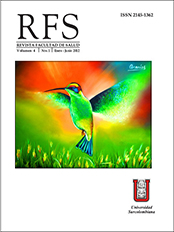Factors associated with medication prescription in pregnant women from ESE Carmen Emilia Ospina: A cross-sectional study
##plugins.themes.bootstrap3.article.main##
Indiscriminate use of medicines in pregnant women calls for a strict surveillance due to the numerous risks such as fetal malformations and an increase in maternal and fetal morbimortality. The fundamental problem lies in the lack of controlled clinical studies about this type of population due to ethical reasons. An observational descriptive cross-sectional period study was conducted, based on the pregnant women who attended the maternity unit of ESE Carmen Emilia Ospina, from September 1, 2011 until February 29, 2012. A sample of 365 patients was obtained whose average age was 22; the use of medicines was by 60 %, being self-medication responsible for 16,7 %, the pharmacological category B had a higher frequency by 82,8 %. The prenatal proper control, which refers to the exertion of this, according to gestational age, was exercised only by 63,2 % of total patients; 78,5 % of pregnant women was in secondary education. Acetaminophen was the main medicine taken by 30%, followed by hyoscine by 18%, metoclopramide by 7% and cephalexin by 5%. Other medicines such as metronidazole, hyoscine plus dipyrone, cephradine ranitidine, dipyrone were used to a lesser extent. The reasons for prescription were pelvic pain and headache by 29% and 17%, respectively. A multivariate analysis of logistic regression was carried out which showed that the second half of the gestation term is a protective factor for medicine taking during gestation. Other identified variables such as low cultural level, urban origin and the presence of prenatal controls did not show statistically significant information. As a conclusion, medicine taking by pregnant women is a serious health problem that is fully identified in our region and needs strategic detailed plans for its prevention.
Downloads
##plugins.themes.bootstrap3.article.details##
Laporte JR. La contribución de los medicamentos a la salud. En: Laporte JR, Tognoni G, editores. Principios de epidemiología del medicamento, salud pública. España: editorial masson-salvat. Segunda edición 1993; p. 3-8.
The importance of pharmacovigilance. World health organizations & WHO collaborating centre for international drug monitoring. 2002
Engeland A. Prescription drug use among fathers and mothers before and during pregnancy. A population-based cohort study of 106 000 pregnancies in Norway 2004-2006. British Journal of Clinical Pharmacology. 2008; 65(5):653-660.
Zhu X, Qui X. Pattern of drug use during the first trimester among Chinese women: data from a population-based cohort study. European Journal Clinical Pharmacology (2010);66:511-518.
Donati S, Baglio G. Drug use in pregnancy among Italian women. European Journal Clinical Pharmacology. 2000;56:323-328.
Malm H, Martikainen J. Prescription of Hazardous Drugs during Pregnancy. Drug Safety 2004; 27(12):899-908.
Marín GH. Uso de fármacos durante el período de gestación en embarazadas de Buenos Aires, Argentina. Revista salud pública. 2010;12(5): 722-731.
Orozco Dias JG. Represenciones sociales asociadas al medicamento y su consumo en mujeres gestantes en un hospital del sur, empresa social del estado, de bogota. Universidad nacional de Colombia, 2010.










